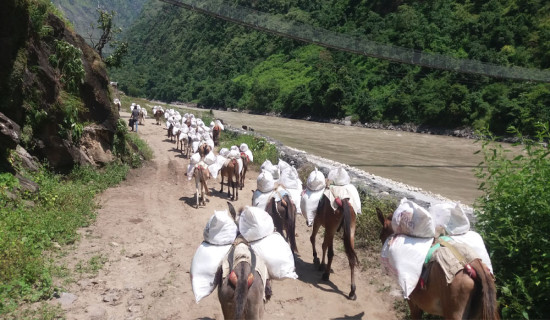- Sunday, 5 May 2024
Accelerating Fight Against Malaria
Malaria is still a scourge for humanity. The disease is primarily transmitted to humans through the bites of infected female Anopheles mosquitoes. The disease not only continues to directly endanger our health and cost lives, but it also perpetuates a vicious cycle of inequity. In particular, the risk of malaria is largely visible among people living in the most vulnerable situations including pregnant women, infants, children under five years of age, migrants and internally displaced people. More importantly, indigenous people also continue to be at high risk of malaria due to the remote local locations and the surrounding social and environmental conditions in which they live.
According to World Malaria Report – 2023, globally in 2022, there were an estimated 249 million malaria cases in 85 malaria endemic countries, an increase of 5 million cases compared with 2021. The main countries contributing to the increase were Pakistan, Ethiopia, Nigeria, Uganda and Papua New Guinea. The WHO South-East Asia Region accounted for about 2 per cent of malaria cases globally. Malaria cases declined by 76 per cent, from 23 million in 2000 to about 5 million in 2022. Malaria case incidence in this region decreased by 83 per cent, from about 18 cases per 1000 population at risk in 2000 to about three cases per 1000 population at risk in 2022.
Impressive gains
Over the years, Nepal has made impressive gains in reducing its malaria burden. Going back to the history malaria control project was first initiated in Nepal in 1954 with the support from USAID. According to Epidemiology and Disease Control Division (EDCD) of Department of Health Services (DoHS), the purpose of the project was to study malaria mainly in Terai belt of central Nepal. In 1958, national malaria eradication programme, was launched with the aim of eradicating malaria from the country.
Following the call of WHO to revamp the malaria control programme in 1998, Roll Back Malaria (RBM) initiative was launched to address the perennial problem of malaria in hard-core forests, foot hills, inner Terai and valley areas of the hills, where more than 70 per cent of the total malaria cases of the country prevail. The high risk of acquiring the disease is attributed to the rising temperature, environmental and socio-economic factors.
As a matter of progress and way forward, Nepal is heading its elimination goal in 2025 with activities rolled out across the districts, including the high, moderate, low and no risk ones. Since 2016, the programme has been updating the microstratification every year and has classified risks at a ward level. While malaria is largely endemic in certain parts of Terai region, the cases have also been reported in the hilly and mountainous regions. The disease exhibits seasonality, with the peak transmission occurring before and after the rainy season.
Even though malaria is preventable and treatable, it continues to have a devastating impact on people’s health and livelihoods around the globe. The morbidity and mortality of the disease are more common in rural populations facing poverty, hunger, limited access to education and health services, poor sanitation and living conditions. Therefore, targeted interventions must aim to overcome social, cultural, economic, geographic, environmental and political barriers to ensure health equity, gender equality, and human rights in malaria responses.
In malaria affected communities around the world, the socio-cultural norms and gender-dynamics within families and households profoundly influences women’s ability to access, and decision making power in seeking malaria prevention and care. Evidence suggests that women and girls tend to have less access to information on how to protect themselves from malaria, and how to seek care, due to their limited access to information and community education. Other socio-cultural norms and gender-related health vulnerabilities can also increase the risk of malaria and introduce barriers for access. For example, in most communities, men working outdoors in forestry, farming, mining or agriculture, may be at higher risk of malaria – especially when their work occurs during peak mosquito biting times - around dusk.
In recent years, climate change is a significant health threat facing humanity. More notably, climate change is also responsible for more extreme and frequent weather events, such as flooding, which can result in malaria. The likely indirect effects of climate change on malaria could include loss of livelihoods and increased economic and food insecurity, displacements and service disruptions, and variations in access to and quality of health delivery systems.
Technical strategy
Global technical strategy for malaria (2016–2030) is a landmark progress in terms of a comprehensive framework to guide countries in their efforts to accelerate progress towards malaria elimination. According to WHO, the strategy sets the target of reducing global malaria incidence and mortality rates by at least 90 per cent by 2030. In order to sustain the progress, there are critical needs of strengthening resilient health systems in low-and middle-income countries to ensure that people suffering from malaria receive quality health care close to where they work.
More importantly, local strategies must ensure that community are effectively represented and fully engaged in malaria response as care seekers, care providers and promote inter-sectoral actions to address social, cultural, economic, environmental and political determinants of malaria. The anthropological contributions to explore local context and cultural-historical analyses of malaria can be useful to gain a better understanding of the contexts within which malaria occurs and the wider factors that contribute to its persistence. Therefore, social participation is key to sustained malaria response in the country.
(Bhandari is a health policy analyst.)







-square-thumb.jpg)
-original-thumb.jpg)






